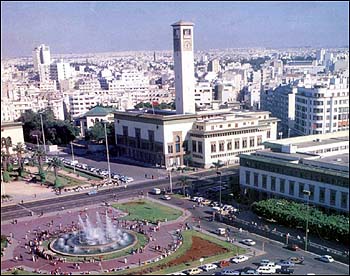The Imbalances of Urban Development in Morocco

The urbanization in Morocco has witnessed a swift development throughout the country as a result of economic, social, cultural and political transformations made during the era of colonization. During that period, the authorities had established neighborhoods outside the fences of ancient cities, in addition to the new urban center, as well as developing the coastal cities that rely on imports and exports.
The demographic growth and rural immigration also contributed to the growth of the urban population that raised, according to the high office of planning, from 20% of the population, in 1936, to 58.30%, in 2011. The urban centers increased from only 27 centers, in 1900, to 400, in 2004.This phenomenon led to dismantling the original urban fabric in Morocco and redistributed the urban offices.
Globalization undoubtedly also has contributed to the deterioration of the urban space, where the economic-adjustment policies imposed on Morocco by the international financial institutions increased the structural imbalances in the Moroccan society and deteriorated the situation both in the cities and villages. The most important results of these policies have been:
- Concentration of cities on the coast, rural and industrial areas and consequently attracting the rural immigrants and depriving the countryside of the human resources and capital and deepening the development gaps between the village and city;
- Encroaching of cities on the agricultural land, forests and coastal space, and consequently shrinking of parks and green spaces inside the cities and causing the absence of beauty and harmony in the urban fabric;
- High demand on housing and infrastructure in the urban centers, thus increasing pollution and accumulation of wastes of all kinds;
- The increase of unemployment and poverty, as well as the increasing of informal sector and lack of social services, particularly urban transportation, schools, hospitals and cultural and sport services;
- The spreading of informal settlements/slums on the urban outskirts and the pressure on the historic city centers, causing their physical and clutural deterioration.
Corruption, that spreads over the administrative and political public space, has taken its turn in adding to the problem of urban imbalances and the deterioration of urban space. This has been evident as the officials ignore the for-profit housing lobbies, in collaboration with the local authorities, designs and allocation of places of housing projects, etc.
The authorities also are tolerating—and even encouraging—illegal housing and slums for their political and security goals, where they exploit the residents of these slums during election rounds to barter for support of a particular candidate or political party. The Moroccan authorities have deepened this approach when they tried to limit the protests that took place within the so-called the ”Arab Spring,” by encouraging the informal settlements over the last year.
According to the Ministry of Housing, the number of informal settlements is approximately 44,000;however, the public security forces after the Benkirane government came to the power, demolished many of these slums in a selective way without warning, causing the displacement of citizens in several cities (Agadir, al-Jadida, Salé, Tangier, Marrakesh, Safi, Qunaitara, Muhammadiyya andMeknes).
During the World Urban Forum (WUF) in Naples (5–9 September 2012), the Government of Morocco was marketing its policies in the field of reconstruction in the city. They tried to convince the participants of the utility of its major projects, such as the high speed train that will link Casablanca and Tangier. Many Moroccan people consider this as a model for wasting public money, as many do not consider this project to be of the citizens` priorities and interests. They recall the project of the tramway in Rabat and Casablanca, which contributed to the worsening the crisis of urban transport, rather than resolving it.
Additionally, other schemes aimed at the elimination slums have obvious imbalances, because of the absence of a clear strategy for addressing corruption within the administrative and political circles that are producing low-standard of housing. The government also has marketed new projects aimed at alleviating the population density for some large cities, such as Rabat, Casablanca, Marrakech and Tangier, which were not successful due to the lack of sufficient social and economic infrastructure, particularly schools, hospitals, working areas and urban transport for those who must commute to work.
As asserted in the accompanying article of Arab politics and urban planning, critical analysis of such urban planning patterns is indispensable to that democratizing alternative processes may prevail.
|